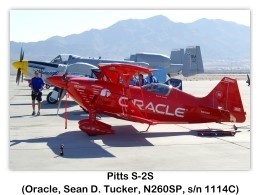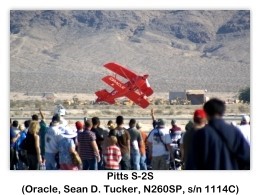

























Pitts S-2S Special
Two-seat aerobatic biplane
Archive Photos 1
Pitts S-2S Special (N260SP, c/n 1114c, 1981) Sean D. Tucker performing in the Oracle at the 2007 Nellis AFB Airshow, Las Vegas, Nevada (Photos by John Shupek)


Overview 3
Production of this single-seat version of the Pitts S-2A began in late 1978. It has a forward fuselage shortened by 14 in (0.36 m) to accommodate a 260 hp (194 kW) Textron Lycoming AEIO-540-D4A5 flat-six engine, driving and McCauley Type 1A/200 two-blade fixed-pitched metal propeller with a spinner. It also differs from the Pitts S-2A by having a maximum fuel capacity of 35 US gallons (132.5 leaders; 29.1 Imp gallons) and an oil capacity of 3 US gallons (11.4 liters; 2.5 Imp gallons). The first flight of the prototype was made on 9 December 1977. Full type certification was gained in June 1981. The Model S-2S was available by special orders only.
Design and Development 2
Curtis Pitts began the design of a single-seat aerobatic biplane in 1943-1944. The design has been refined continuously since the prototype’s first flight in September 1944, however, the current Pitts S2 still remains quite close to the original in concept and in design.
Several of the aircraft that Curtis Pitts built had a picture of a skunk on them and were called Stinkers. After she bought it, aerobatic performer Betty Skelton called the second aircraft that Curtis built, Lil’ Stinker. The prototype S-2, which was the first two-seat Pitts, was Big Stinker, the prototype Model 11 (later called S1-11B) was Super Stinker, and the prototype Model 12 was the Macho Stinker.
In 1962 Curtis Pitts set up Pitts Enterprises to sell plans of the Pitts S-1C to home builders.
Operational History 2
All single-seat (S-1) and two-seat (S-2) Pitts Specials are variations on the basic design from 1944.
The aircraft was popularized by Betty Skelton, Caro Bayley and other air show performers, which led to the offering of plans in 1962.
Pitts produced limited numbers of aircraft during the 1940s and 1950s. It is widely accepted that the Pitts Special is the standard by which all other aerobatic aircraft are judged. After a number of home-built aircraft were produced from rough hand-drawn plans produced by Pitts, more professionally drawn plans went on sale in 1962. While many home-built aircraft were built in the 1960s, earning the Pitts S-1 a reputation as an excellent aerobatic aircraft, Pitts worked on the design of a two-seat aerobatic trainer version, the Pitts S-2, which first flew in 1967 and gained its type certificate in 1971. Factory-built aircraft produced by the Aerotek company at Afton, Wyoming were joined in production by the single-seat S-1S in 1973.
The design’s popularity grew significantly following Bob Herendeen’s participation on the USA Aerobatic Team in a Pitts Special in the World Aerobatic Competition in Moscow, Russia in 1966. In 1972, the US National Aerobatic Team won the World Championships flying only Pitts biplanes.
In 1977 Curtis Pitts sold his interests in the Pitts S-1 and S-2 to Doyle Child. Child later sold the rights in 1981 to Frank Christenson, who continued production at the Afton plant under the guise of Christen Industries. The rights for home-built versions of the Pitts were sold in 1994 to Steen Aero Lab, with the Afton factory and production rights being transferred to Aviat.
Curtis Pitts died in 2005 at age 89. At the time of his death, he was working with Steen on the prototype of the new Pitts Model 14, a brand-new, two-seat biplane designed for unlimited aerobatics powered by the 400 horsepower Vedeneyev M14P radial engine. The rights to the Pitts name is currently owned by Aviat which also owns the similar model to the Pitts in the Christen Eagle.
Current Versions 2
Certified versions of the compact Pitts are now produced by Aviat in Afton, Wyoming. It is available as an S-1 single-seater with up to 200 hp (150 kW) flat-4 Lycoming engine and a 17 ft 4 in (5.28 m) wingspan, or as an S-2 two-seater variant featuring a 260 hp (194 kW) flat-6 Lycoming and a 20 ft (6.1 m) wingspan. Pitts Specials have been equipped with engines of up to 450 hp (338 kW).
The Pitts held sway over the aerobatic world championships until the rise of the monoplane, though it remains very competitive in all levels of competition and remains a favorite of air show performers worldwide. The first monoplane to topple the Pitts from the top of unlimited aerobatic competition was the Russian-built and designed Yak-50.
Today, the single-seat Pitts S-1S plans are available from Aviat Aircraft. The S-1C and derivative S-1SS plans and kits are supplied by Steen Aero Lab in Palm Bay, Florida. The S-1 continues to provide extremely high performance at a relatively low cost. Many hundreds of home-builders have successfully completed and flown the Pitts since plans became available in 1960.
Variants 2
- S-1: Basic single-seat Pitts aerobatic biplane with a flat M6 aerofoil section and lower wing ailerons only, fitted with a variety of engines. Two were built, the first named Special and the second Li’l Stinker.
- S-1C: Amateur-built S-1 single-seat aircraft, flat bottom wing with ailerons on lower wing only, designed for 100-180 hp (75-134 kW) engines. First flown in 1960, the S-1 is currently available as a plans-built aircraft from Steen Aero Lab.
- S-1D: Amateur-built S-1C with ailerons on all four wings, generally similar to S-1S.
- S-1E: Amateur-built S-1C using factory-produced kits. Uses symmetrical airfoil.
- S-1F: Outside derivative homebuilt, with the Falcon wing. Square tips, 25% more aileron span. In the UK, this model is fitted with a 200 hp (149 kW) Monty Barrett engine, and a lightweight Hoffmann VP propeller.
- S-1S: Aerotek-built certified S-1C for competition aerobatics, round aerofoil section, four ailerons and powered by a 180 hp (134 kW) Lycoming AEIO-360-B4A; 61 built. This model is also available from Aviat Aircraft as a plans-built aircraft.
- S1-SS: Similar to the certified S1-S Roundwing. 180-200+ hp (134-149 kW), single-seat, homebuilt, symmetrical wing, four symmetrical Super-Stinker style ailerons, 300 degree/sec roll rate, fixed pitch propeller. This model is available in plans and components form from Steen Aero Lab.
- S1-1T Aerotek-built S-1C with a 200 hp (149 kW) Lycoming AEIO-360-A1E and minor changes; 64 built. Four-aileron, single-seat, factory-built, symmetrical wing, symmetrical ailerons, constant speed two- or three-blade Hartzell propeller. The top wing was moved forward compared to the S-1S for weight and balance. This model is in production in 2008 from Aviat Aircraft as an "on-demand" manufacture product.
- S-1-11B: Known as Model 11 Super Stinker , 300+ hp (220 kW) Lycoming, four-aileron, single-seat, experimental-plans or factory-built and factory component parts, symmetric airfoil, three-blade constant speed prop, rolls better than 300 degree/sec, climbs better than 3,000 ft/min (15.3 m/sec).
- S-2 Scaled up S-1 with tandem two-seat fuselage and powered by a 200 hp (149 kW) Lycoming AEIO-360-B4A piston engine.
- S-2A: Aerotek-built S-2A with a 200 hp (149 kW) Lycoming AEIO-360-A1A or -A1E piston engine, constant speed propeller, later builds has a longer landing gear and a 2-inch-wider (51 mm) front cockpit; 259 built.
- S-2B: Aerotek-built S-2A with a 260 hp (194 kW) Lycoming AEIO-540-D4A5 engine, and upper wing auxiliary fuel tank, the landing gear and upper wings were moved forward six inches; 196 built. The aircraft is out of production but is supported by Aviat Aircraft.
- S-2C: Four aileron, two-seat, factory-built, symmetric airfoil, 260 hp (194 kW) Lycoming driving constant speed three-blade propeller, current production model. This was an evolution of the S-2B model, with improved ailerons and rudder, flat bottom fuselage, lower profile bungee gear, better inverted handling and certified for +6 -5g. It is in production in 2008 by Aviat Aircraft.
- S-2E: Amateur-built S-2A from factory-produced kits.
- S-2S: Aerotek-built S-2B with a single cockpit and a twin tank fuel system. The fuselage is shortened by 14 inches (35 cm) forward of the cockpit to allow the installation of the heavier 260 hp (194 kW) Lycoming AEIO-540-D4A5. The wingspan is 20 ft, 0 inches (6.10 m); 17 built. This model is currently out of production, but supported by Aviat Aircraft.
- S-2SE: Amateur-built S-2S from factory-produced kits.
Specifications (S-2S) 3
Type
- Two-seat aerobatic biplane.
Manufacturer
- Christen Industries, Inc., Afton Wyoming
Wings
- Braced biplane type, with single faired interplane strut each side of N-type cabane struts.
- Wing section NACA 6400 series on upper wing, 00 series on lower wings.
- Two-spar spruce structure with fabric covering.
- Ailerons on both upper and lower wings, with aerodynamic ‘spade’ balances on lower ailerons.
- No flaps or tabs.
Fuselage
- Welded 4130 steel tube structure, covered with wooden stringers, covered with Dacron except for aluminum top decking side panels.
Tail Unit
- Wire-braced 4130 steel-tube structure.
- Fixed surfaces metal covered, control surfaces fabric covered.
- Trim tab in each elevator.
Landing Gear
- Non-retractable tailwheel type.
- Rubber-cord shock-absorption.
- Steerable tailwheel.
- Streamlined fairings on main wheels.
Power Plant
- One 260 hp (194 kW) Textron Lycoming AEIO-540-D4A5 flat-six engine.
- McCauley Type 1A/200 two-blade constant-speed metal propeller with spinner.
- Fuel tank in fuselage immediately aft of firewall, capacity 35 US gallons (132.5 liters; 29.1 Imp gallons).
- Refueling point on upper surface forward of windscreen.
- Oil capacity 3 US gallons (11.4 liters; 2.5 Imp gallons).
- Inverted fuel and oil systems standard.
Accommodation
- Two seats in tandem cockpits, with dual controls.
- Sideways opening one-piece canopy covers both cockpits.
- Space for 20 lb (9.1 kg) baggage aft of rear seat when flown in non-aerobatic category.
System
- Electrical system powered by 12V 40A alternator and non-spill 12V battery.
Dimensions, External
- Wing span, upper: 20 ft 0 in (6.10 m)
- Wing span, lower: 19 ft 0 in (5.79 m)
- Wing chord (constant, both): 3 ft 4 in (1.02 m).
- Length overall: 17 ft 4 in (5.28 m)
- Height overall: 6 ft 7½ in (2.02 m)
Areas
- Wings, gross: 125.0 ft² (11.6 m²)
Weights
- Weight empty: 1,100 lb (499 kg)
- Maximum take-off weight: 1,500 lb (680 kg)
Loadings
- Maximum wing loading: 12.0 lb/ft² (58.6 kg/m²)
- Maximum power loading: 5.77 lb/hp (3.51 kg/hp)
Performance at Maximum Takeoff Weight
- Maximum never-exceeding speed: 203 mph (176 knots; 326 kmh)
- Maximum level speed at sea level: 187 mph (162 knots; 301 kmh)
- Maximum cruising speed at sea level: 175 mph (152 knots; 282 kmh)
- Stalling speed: 58 mph (51 knots; 94 kmh)
- Maximum rate of climb at sea level: 2,800 ft/min (853 m/min)
- g limits: +9/-4.5
References
- Photos: John Shupek
- Wikipedia, Pitts Special
- Taylor, John W. R. and Munson, Kenneth (editors). Pitts Model S-2S, Jane’s All The World’s Aircraft 1988-89, Jane’s Defence Data, ISBN 0-7106-0867-5, 1988, page 381

































































